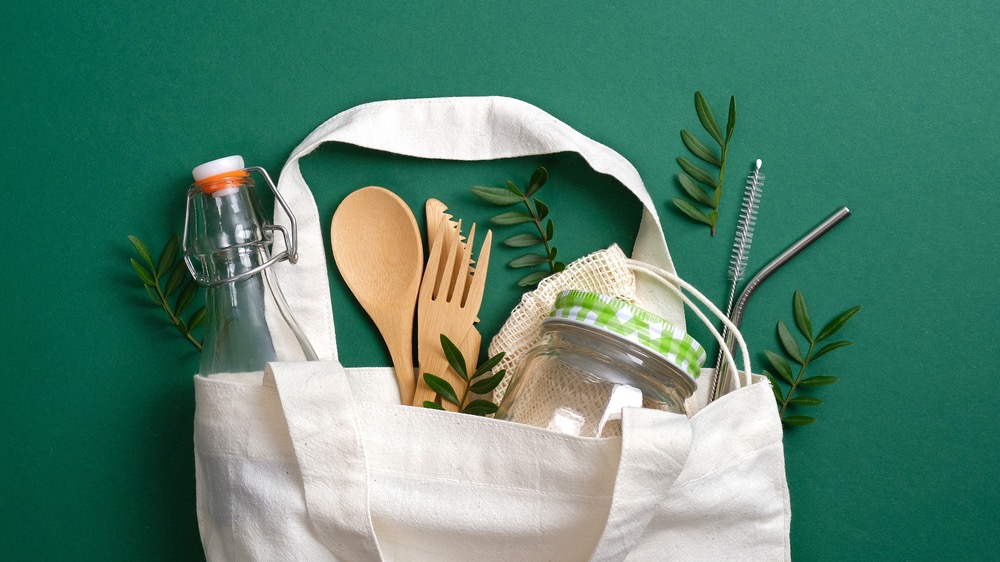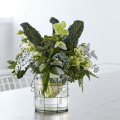It’s hard not to feel a twinge of guilt when we buy products in packaged plastic and throw away snack wrappers or coffee cups. Personally, I do. Ready to make some changes? I am! Here are some ways we can all make a difference.

Audit what you have and how you shop.
Look through your pantry, fridge, bathroom cabinets, laundry room, shed and more and see what it is packaged in. Assess whether it’s made to be thrown out when it’s done, recycled or reused. Next, decide what unpackaged items – pantry staples like flour, rice, dried beans, spices and grains – you can purchase next time in bulk using refillable containers. It’s worth noting that these grocery swaps can be less expensive in the long run.
I actually keep my pantry items on display in my kitchen. They look great, and I can access what I need very easily. I even store carrot sticks, celery and other chopped veggies in large (pickle) jars in the fridge.
And don’t forget that shampoo, detergent and body wash products are available in bulk too.
Go plastic free.
Or, as plastic-free as you can by adopting new habits. Use a refillable water bottle, avoid plastic straws and bags, and refuse items with excessive packaging — shopping at farmers’ markets when you can is a great way to do this.
Some easy swaps:
| Old You | New You |
| Bring home restaurant leftovers in a styrofoam container. | Pack a stainless steel container for leftovers. |
| Use plastic wrap to keep food fresh. | Use reusable beeswax wraps to keep food fresh. |
| Sip drinks with plastic straws. | Carry a stainless steel or glass straw with you. (Clean them regularly with a thin bottle brush.) |
| Grab plastic utensils for takeout food. | Keep a stainless steel fork, knife and spoon in your bag. |
| Buy reusable plastic water bottles. | Buy reusable glass or stainless steel bottles, tumblers and sippy cups. |

Challenge your household to adopt Plastic-Free July.
Plastic Free July is a global movement that helps millions of people be part of the solution to plastic pollution. It shows that when many people take action, we can make an impact — and have cleaner streets, oceans, and beautiful communities. Find resources at www.plasticfreejuly.org.
Canada is a major – and growing – producer of plastics and, according to Environmental Defence, the world’s second-highest user of plastic on a per-person basis. Further, one-third of our plastics are created solely for product packaging, states Oceana Canada, which is discarded after just one use. Yes, discarded! And less than 11 percent of Canada’s plastics get recycled. The rest end up in our landfills, lakes, parks, and oceans, destroying ecosystems and leaching toxic chemicals.
Environmental Defence
Give single-use plastic a second job.
If you already have plastic in your household, use it again for a different purpose. Takeout containers can store home-cooked food, bread bags can be cleaned with soapy water and cut into strips to use as plastic wrap, and those bright green berry baskets make excellent storage containers for your cookie cutters, craft supplies and toiletries.
Recycle thoughtfully.
Some items can’t be recycled at all, and when they are added to the blue bin, they contaminate everything in there. What these items are, depends on where you live. Still, the main culprits to think about are black plastics (like plant pots and takeout containers), takeout coffee cups, coffee pods (though some brands have a specific program to take them back) and stand-up, resealable pouches (often how frozen fruit and veggies are packaged). This list is much longer, so don’t put something in the recycling bin and hope it will be recycled when it can’t. That’s called ‘wishcycling,’ and by doing that, you may ruin your efforts to live more sustainably.

22 Ways to Conserve Water at Home
Speak up.
Reach out to companies to let them know that you like their products but not their packaging. Let all levels of government know you feel the same. Share what you know with friends and neighbours.
Be realistic.
Although you alone cannot solve the plastic waste issue, rest assured that many people worldwide share your concern and, like you, are taking action to address it.
We can create change when you and I join others in implementing some of these small habits.

Jennifer Reynolds, our previous Editor-in-Chief, is a long-time authority in gardening, do-it-yourself projects, urban sustainability, parenting, placemaking and community matters. Her features and columns have been published in Canadian Living, Canadian Family, Gardening Life, House & Home, Globe & Mail, National Post, Toronto Star & more. Plus, her designs and expertise have been featured on dozens of HGTV, W Network and CTV shows.











